ICT700 System Analysis and Design: A Case Study of Odd Jobs Limited
VerifiedAdded on 2023/06/04
|15
|2670
|78
Case Study
AI Summary
This document presents a system analysis and design case study focused on Odd Jobs Limited, examining the application of adaptive methodologies such as Scrum and Extreme Programming (XP). It discusses the advantages and disadvantages of each methodology, recommending Scrum for its suitability in developing innovative systems within the organization due to its cost-effectiveness and efficient project management capabilities. The study includes modeling and diagramming techniques, featuring an event table, domain model class diagram, design class diagram, and use case diagram with detailed descriptions. The analysis aims to improve processes for contracting staff and customer invoicing, highlighting the importance of requirement gathering and data collection for successful system development. The document also contains a memo outlining strategies for gathering requirements for the development of a mobile application for Odd Jobs Limited.

Running head: SYSTEM ANALYSIS AND DESIGN
System Analysis and Design: A Case Study of Odd Jobs Limited
Name of the Student:
Name of the University:
System Analysis and Design: A Case Study of Odd Jobs Limited
Name of the Student:
Name of the University:
Paraphrase This Document
Need a fresh take? Get an instant paraphrase of this document with our AI Paraphraser
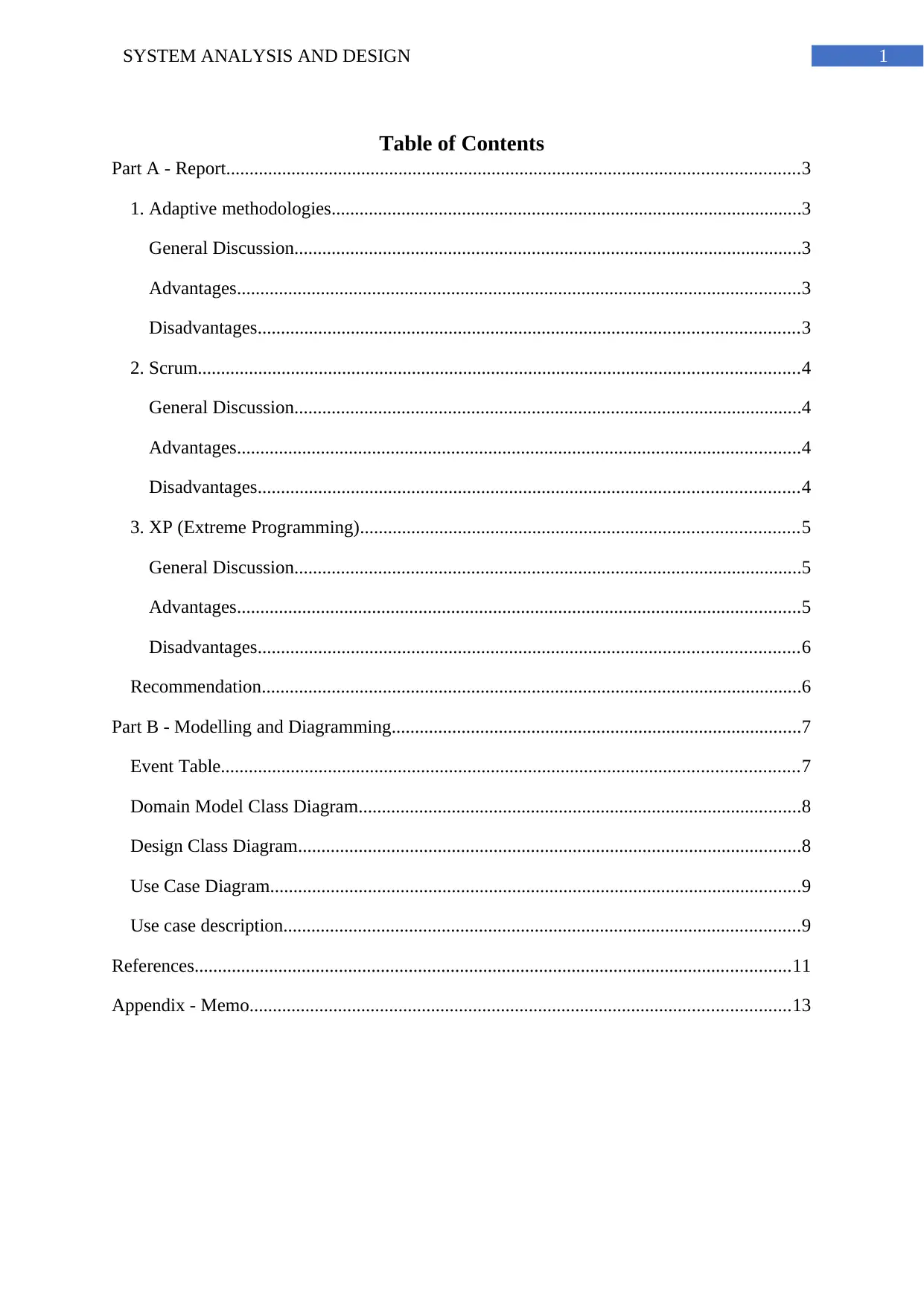
1SYSTEM ANALYSIS AND DESIGN
Table of Contents
Part A - Report...........................................................................................................................3
1. Adaptive methodologies.....................................................................................................3
General Discussion.............................................................................................................3
Advantages.........................................................................................................................3
Disadvantages....................................................................................................................3
2. Scrum.................................................................................................................................4
General Discussion.............................................................................................................4
Advantages.........................................................................................................................4
Disadvantages....................................................................................................................4
3. XP (Extreme Programming)..............................................................................................5
General Discussion.............................................................................................................5
Advantages.........................................................................................................................5
Disadvantages....................................................................................................................6
Recommendation....................................................................................................................6
Part B - Modelling and Diagramming........................................................................................7
Event Table............................................................................................................................7
Domain Model Class Diagram...............................................................................................8
Design Class Diagram............................................................................................................8
Use Case Diagram..................................................................................................................9
Use case description...............................................................................................................9
References................................................................................................................................11
Appendix - Memo....................................................................................................................13
Table of Contents
Part A - Report...........................................................................................................................3
1. Adaptive methodologies.....................................................................................................3
General Discussion.............................................................................................................3
Advantages.........................................................................................................................3
Disadvantages....................................................................................................................3
2. Scrum.................................................................................................................................4
General Discussion.............................................................................................................4
Advantages.........................................................................................................................4
Disadvantages....................................................................................................................4
3. XP (Extreme Programming)..............................................................................................5
General Discussion.............................................................................................................5
Advantages.........................................................................................................................5
Disadvantages....................................................................................................................6
Recommendation....................................................................................................................6
Part B - Modelling and Diagramming........................................................................................7
Event Table............................................................................................................................7
Domain Model Class Diagram...............................................................................................8
Design Class Diagram............................................................................................................8
Use Case Diagram..................................................................................................................9
Use case description...............................................................................................................9
References................................................................................................................................11
Appendix - Memo....................................................................................................................13
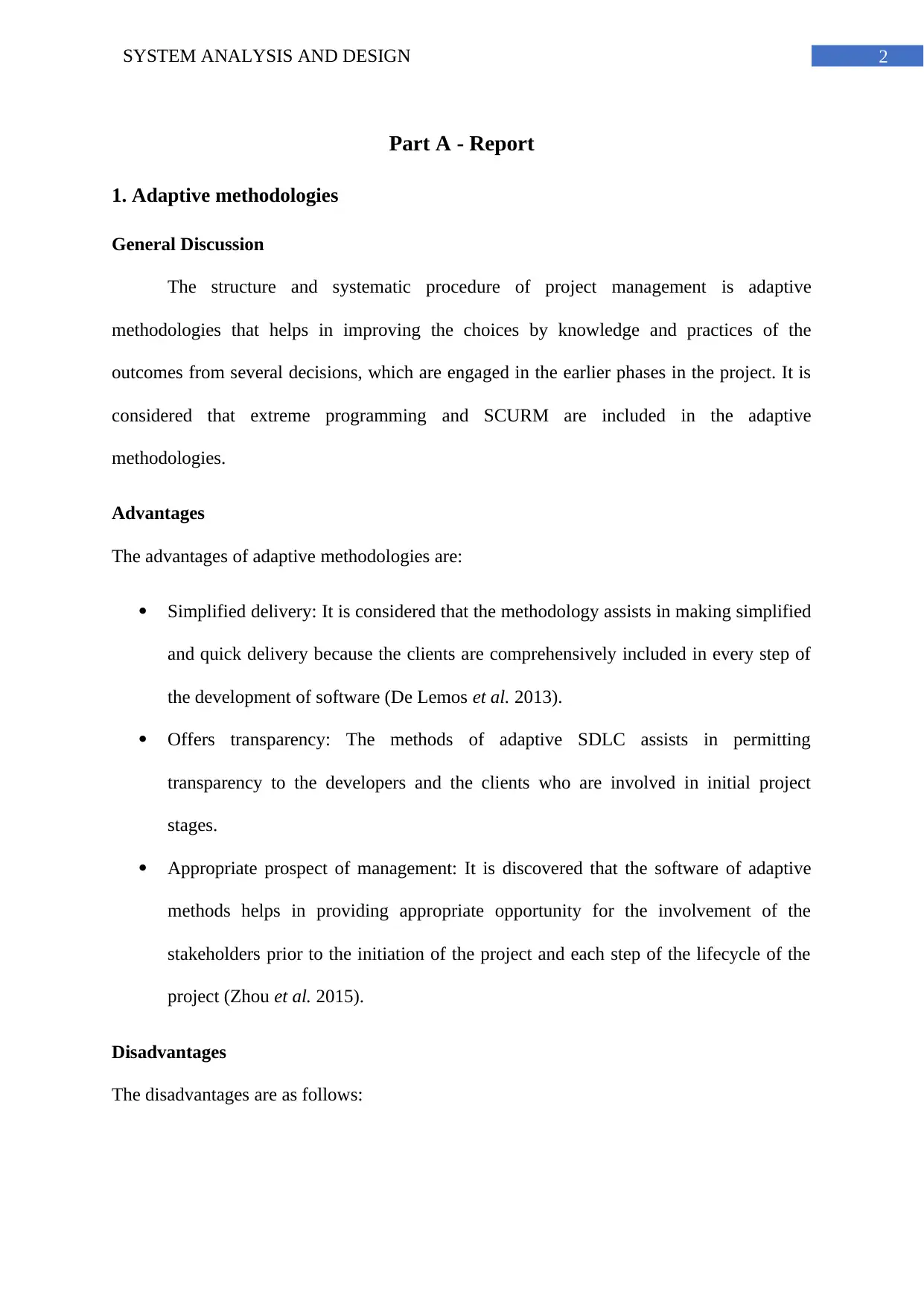
2SYSTEM ANALYSIS AND DESIGN
Part A - Report
1. Adaptive methodologies
General Discussion
The structure and systematic procedure of project management is adaptive
methodologies that helps in improving the choices by knowledge and practices of the
outcomes from several decisions, which are engaged in the earlier phases in the project. It is
considered that extreme programming and SCURM are included in the adaptive
methodologies.
Advantages
The advantages of adaptive methodologies are:
Simplified delivery: It is considered that the methodology assists in making simplified
and quick delivery because the clients are comprehensively included in every step of
the development of software (De Lemos et al. 2013).
Offers transparency: The methods of adaptive SDLC assists in permitting
transparency to the developers and the clients who are involved in initial project
stages.
Appropriate prospect of management: It is discovered that the software of adaptive
methods helps in providing appropriate opportunity for the involvement of the
stakeholders prior to the initiation of the project and each step of the lifecycle of the
project (Zhou et al. 2015).
Disadvantages
The disadvantages are as follows:
Part A - Report
1. Adaptive methodologies
General Discussion
The structure and systematic procedure of project management is adaptive
methodologies that helps in improving the choices by knowledge and practices of the
outcomes from several decisions, which are engaged in the earlier phases in the project. It is
considered that extreme programming and SCURM are included in the adaptive
methodologies.
Advantages
The advantages of adaptive methodologies are:
Simplified delivery: It is considered that the methodology assists in making simplified
and quick delivery because the clients are comprehensively included in every step of
the development of software (De Lemos et al. 2013).
Offers transparency: The methods of adaptive SDLC assists in permitting
transparency to the developers and the clients who are involved in initial project
stages.
Appropriate prospect of management: It is discovered that the software of adaptive
methods helps in providing appropriate opportunity for the involvement of the
stakeholders prior to the initiation of the project and each step of the lifecycle of the
project (Zhou et al. 2015).
Disadvantages
The disadvantages are as follows:
⊘ This is a preview!⊘
Do you want full access?
Subscribe today to unlock all pages.

Trusted by 1+ million students worldwide
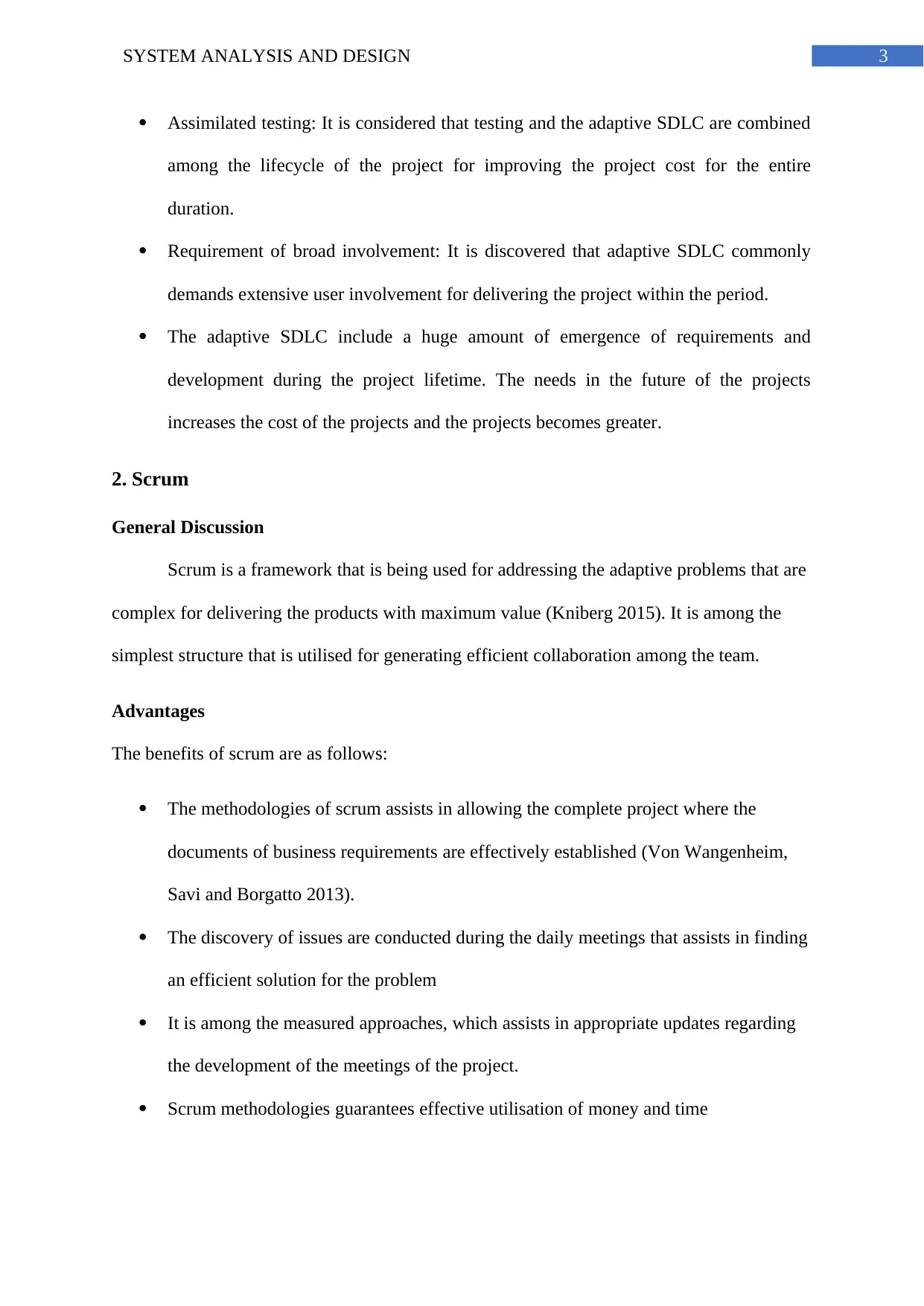
3SYSTEM ANALYSIS AND DESIGN
Assimilated testing: It is considered that testing and the adaptive SDLC are combined
among the lifecycle of the project for improving the project cost for the entire
duration.
Requirement of broad involvement: It is discovered that adaptive SDLC commonly
demands extensive user involvement for delivering the project within the period.
The adaptive SDLC include a huge amount of emergence of requirements and
development during the project lifetime. The needs in the future of the projects
increases the cost of the projects and the projects becomes greater.
2. Scrum
General Discussion
Scrum is a framework that is being used for addressing the adaptive problems that are
complex for delivering the products with maximum value (Kniberg 2015). It is among the
simplest structure that is utilised for generating efficient collaboration among the team.
Advantages
The benefits of scrum are as follows:
The methodologies of scrum assists in allowing the complete project where the
documents of business requirements are effectively established (Von Wangenheim,
Savi and Borgatto 2013).
The discovery of issues are conducted during the daily meetings that assists in finding
an efficient solution for the problem
It is among the measured approaches, which assists in appropriate updates regarding
the development of the meetings of the project.
Scrum methodologies guarantees effective utilisation of money and time
Assimilated testing: It is considered that testing and the adaptive SDLC are combined
among the lifecycle of the project for improving the project cost for the entire
duration.
Requirement of broad involvement: It is discovered that adaptive SDLC commonly
demands extensive user involvement for delivering the project within the period.
The adaptive SDLC include a huge amount of emergence of requirements and
development during the project lifetime. The needs in the future of the projects
increases the cost of the projects and the projects becomes greater.
2. Scrum
General Discussion
Scrum is a framework that is being used for addressing the adaptive problems that are
complex for delivering the products with maximum value (Kniberg 2015). It is among the
simplest structure that is utilised for generating efficient collaboration among the team.
Advantages
The benefits of scrum are as follows:
The methodologies of scrum assists in allowing the complete project where the
documents of business requirements are effectively established (Von Wangenheim,
Savi and Borgatto 2013).
The discovery of issues are conducted during the daily meetings that assists in finding
an efficient solution for the problem
It is among the measured approaches, which assists in appropriate updates regarding
the development of the meetings of the project.
Scrum methodologies guarantees effective utilisation of money and time
Paraphrase This Document
Need a fresh take? Get an instant paraphrase of this document with our AI Paraphraser
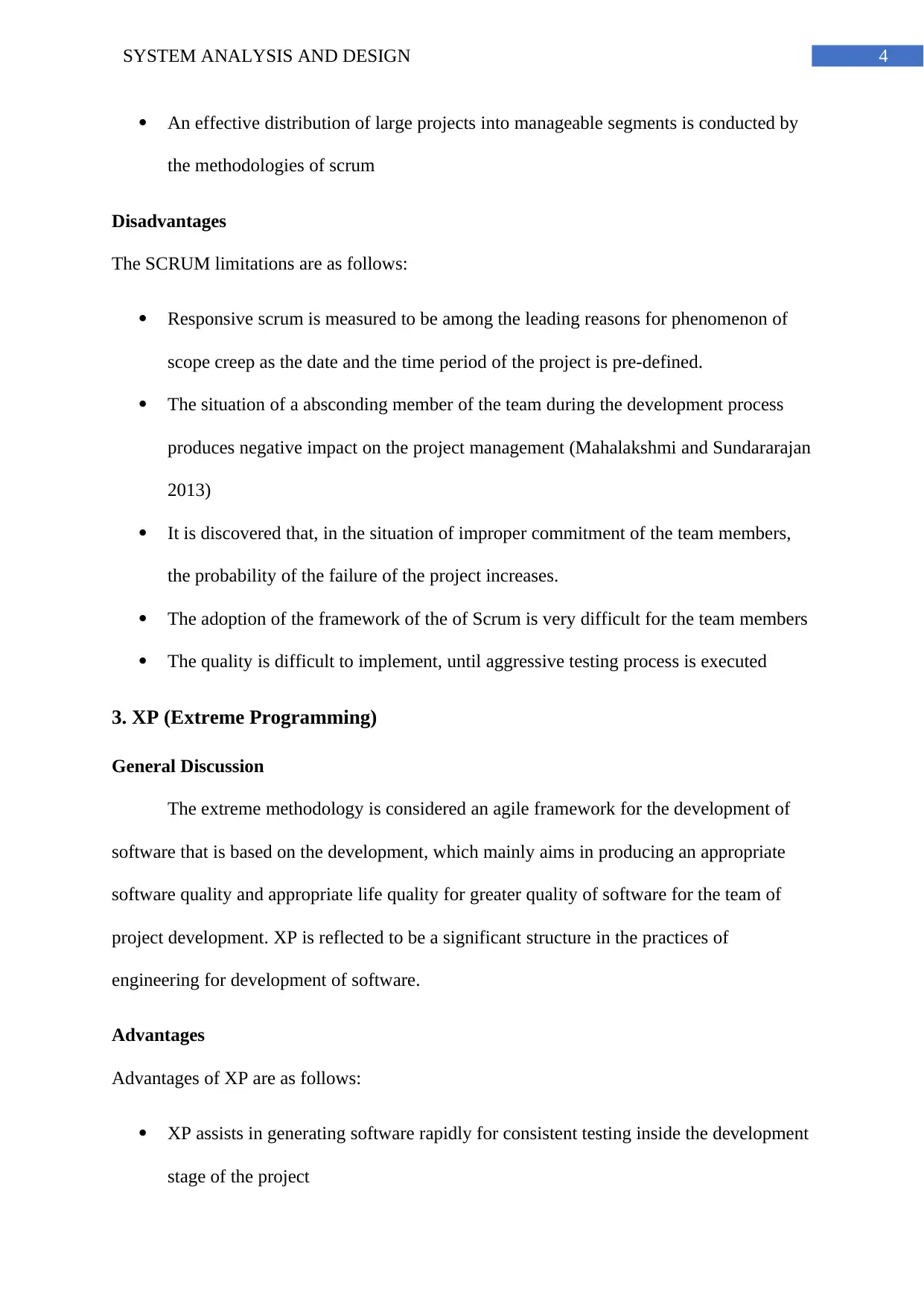
4SYSTEM ANALYSIS AND DESIGN
An effective distribution of large projects into manageable segments is conducted by
the methodologies of scrum
Disadvantages
The SCRUM limitations are as follows:
Responsive scrum is measured to be among the leading reasons for phenomenon of
scope creep as the date and the time period of the project is pre-defined.
The situation of a absconding member of the team during the development process
produces negative impact on the project management (Mahalakshmi and Sundararajan
2013)
It is discovered that, in the situation of improper commitment of the team members,
the probability of the failure of the project increases.
The adoption of the framework of the of Scrum is very difficult for the team members
The quality is difficult to implement, until aggressive testing process is executed
3. XP (Extreme Programming)
General Discussion
The extreme methodology is considered an agile framework for the development of
software that is based on the development, which mainly aims in producing an appropriate
software quality and appropriate life quality for greater quality of software for the team of
project development. XP is reflected to be a significant structure in the practices of
engineering for development of software.
Advantages
Advantages of XP are as follows:
XP assists in generating software rapidly for consistent testing inside the development
stage of the project
An effective distribution of large projects into manageable segments is conducted by
the methodologies of scrum
Disadvantages
The SCRUM limitations are as follows:
Responsive scrum is measured to be among the leading reasons for phenomenon of
scope creep as the date and the time period of the project is pre-defined.
The situation of a absconding member of the team during the development process
produces negative impact on the project management (Mahalakshmi and Sundararajan
2013)
It is discovered that, in the situation of improper commitment of the team members,
the probability of the failure of the project increases.
The adoption of the framework of the of Scrum is very difficult for the team members
The quality is difficult to implement, until aggressive testing process is executed
3. XP (Extreme Programming)
General Discussion
The extreme methodology is considered an agile framework for the development of
software that is based on the development, which mainly aims in producing an appropriate
software quality and appropriate life quality for greater quality of software for the team of
project development. XP is reflected to be a significant structure in the practices of
engineering for development of software.
Advantages
Advantages of XP are as follows:
XP assists in generating software rapidly for consistent testing inside the development
stage of the project
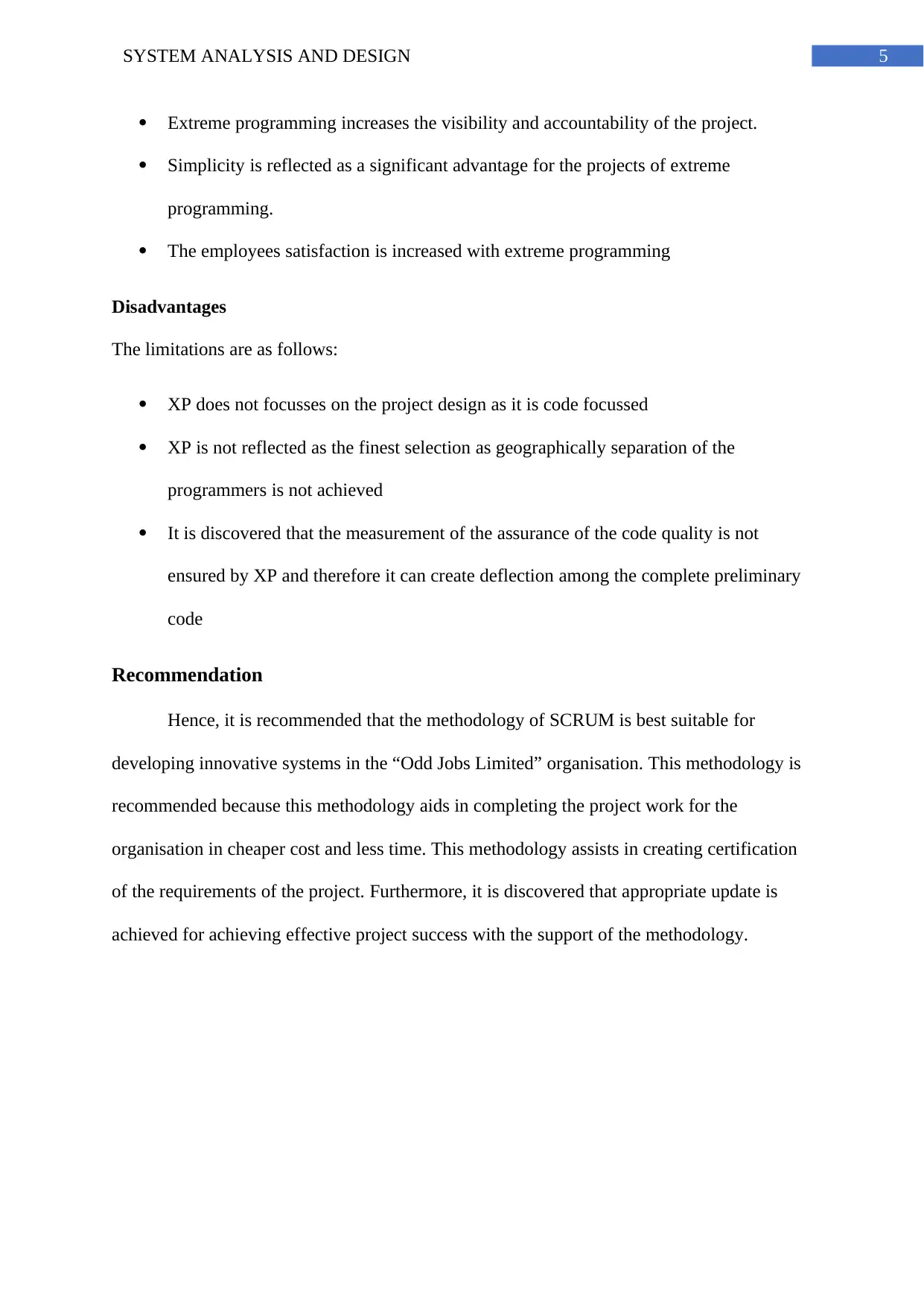
5SYSTEM ANALYSIS AND DESIGN
Extreme programming increases the visibility and accountability of the project.
Simplicity is reflected as a significant advantage for the projects of extreme
programming.
The employees satisfaction is increased with extreme programming
Disadvantages
The limitations are as follows:
XP does not focusses on the project design as it is code focussed
XP is not reflected as the finest selection as geographically separation of the
programmers is not achieved
It is discovered that the measurement of the assurance of the code quality is not
ensured by XP and therefore it can create deflection among the complete preliminary
code
Recommendation
Hence, it is recommended that the methodology of SCRUM is best suitable for
developing innovative systems in the “Odd Jobs Limited” organisation. This methodology is
recommended because this methodology aids in completing the project work for the
organisation in cheaper cost and less time. This methodology assists in creating certification
of the requirements of the project. Furthermore, it is discovered that appropriate update is
achieved for achieving effective project success with the support of the methodology.
Extreme programming increases the visibility and accountability of the project.
Simplicity is reflected as a significant advantage for the projects of extreme
programming.
The employees satisfaction is increased with extreme programming
Disadvantages
The limitations are as follows:
XP does not focusses on the project design as it is code focussed
XP is not reflected as the finest selection as geographically separation of the
programmers is not achieved
It is discovered that the measurement of the assurance of the code quality is not
ensured by XP and therefore it can create deflection among the complete preliminary
code
Recommendation
Hence, it is recommended that the methodology of SCRUM is best suitable for
developing innovative systems in the “Odd Jobs Limited” organisation. This methodology is
recommended because this methodology aids in completing the project work for the
organisation in cheaper cost and less time. This methodology assists in creating certification
of the requirements of the project. Furthermore, it is discovered that appropriate update is
achieved for achieving effective project success with the support of the methodology.
⊘ This is a preview!⊘
Do you want full access?
Subscribe today to unlock all pages.

Trusted by 1+ million students worldwide
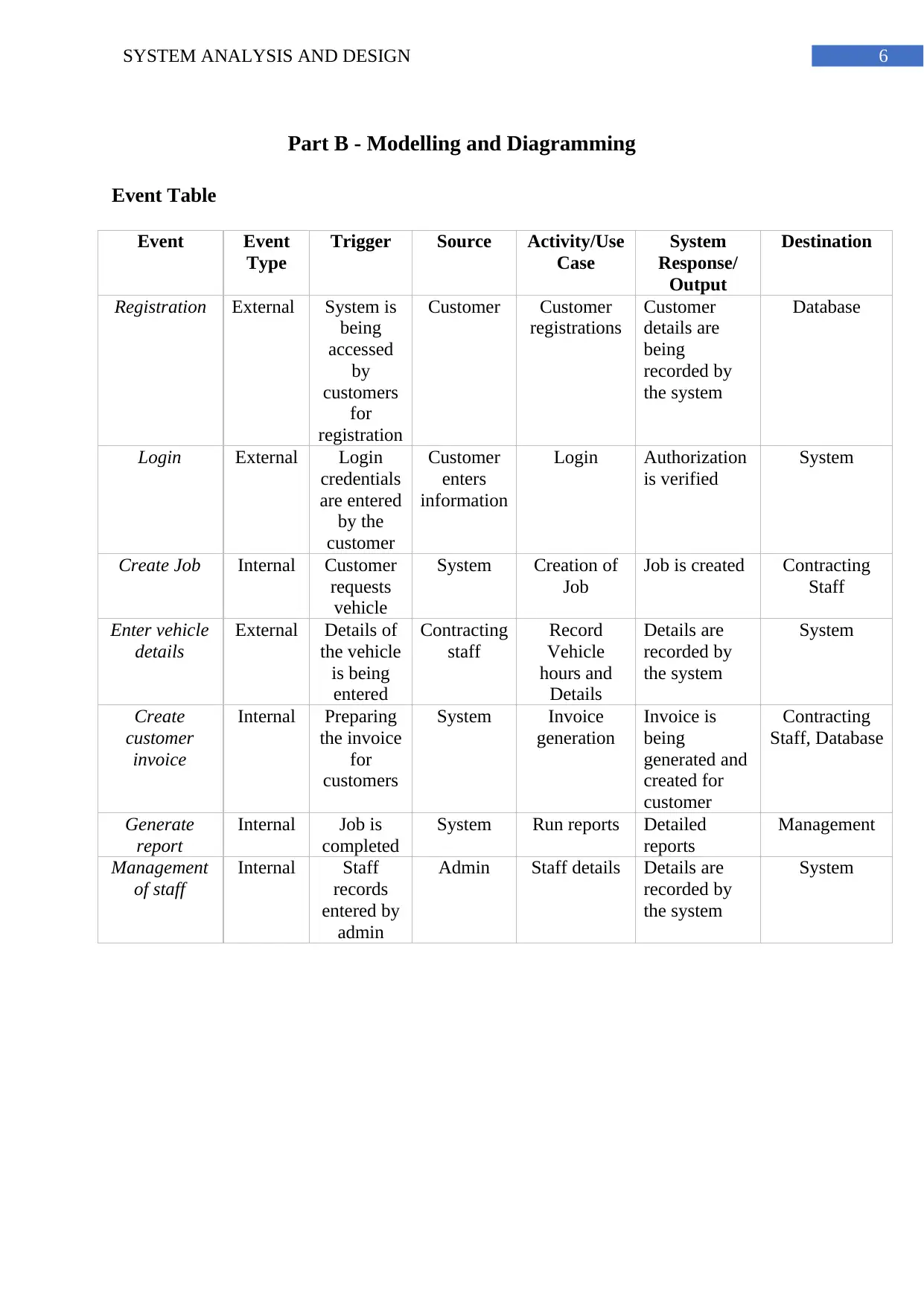
6SYSTEM ANALYSIS AND DESIGN
Part B - Modelling and Diagramming
Event Table
Event Event
Type
Trigger Source Activity/Use
Case
System
Response/
Output
Destination
Registration External System is
being
accessed
by
customers
for
registration
Customer Customer
registrations
Customer
details are
being
recorded by
the system
Database
Login External Login
credentials
are entered
by the
customer
Customer
enters
information
Login Authorization
is verified
System
Create Job Internal Customer
requests
vehicle
System Creation of
Job
Job is created Contracting
Staff
Enter vehicle
details
External Details of
the vehicle
is being
entered
Contracting
staff
Record
Vehicle
hours and
Details
Details are
recorded by
the system
System
Create
customer
invoice
Internal Preparing
the invoice
for
customers
System Invoice
generation
Invoice is
being
generated and
created for
customer
Contracting
Staff, Database
Generate
report
Internal Job is
completed
System Run reports Detailed
reports
Management
Management
of staff
Internal Staff
records
entered by
admin
Admin Staff details Details are
recorded by
the system
System
Part B - Modelling and Diagramming
Event Table
Event Event
Type
Trigger Source Activity/Use
Case
System
Response/
Output
Destination
Registration External System is
being
accessed
by
customers
for
registration
Customer Customer
registrations
Customer
details are
being
recorded by
the system
Database
Login External Login
credentials
are entered
by the
customer
Customer
enters
information
Login Authorization
is verified
System
Create Job Internal Customer
requests
vehicle
System Creation of
Job
Job is created Contracting
Staff
Enter vehicle
details
External Details of
the vehicle
is being
entered
Contracting
staff
Record
Vehicle
hours and
Details
Details are
recorded by
the system
System
Create
customer
invoice
Internal Preparing
the invoice
for
customers
System Invoice
generation
Invoice is
being
generated and
created for
customer
Contracting
Staff, Database
Generate
report
Internal Job is
completed
System Run reports Detailed
reports
Management
Management
of staff
Internal Staff
records
entered by
admin
Admin Staff details Details are
recorded by
the system
System
Paraphrase This Document
Need a fresh take? Get an instant paraphrase of this document with our AI Paraphraser
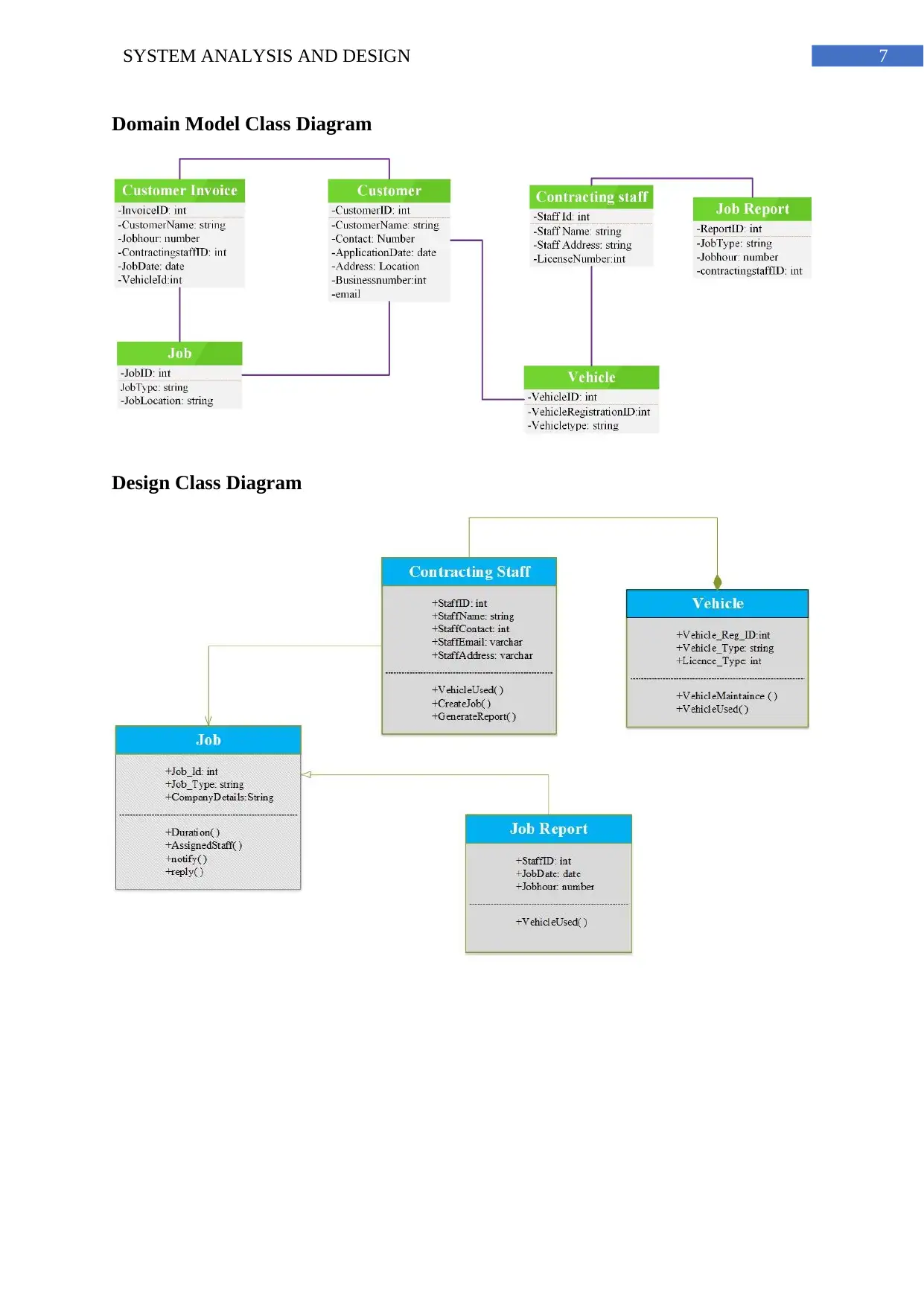
7SYSTEM ANALYSIS AND DESIGN
Domain Model Class Diagram
Design Class Diagram
Domain Model Class Diagram
Design Class Diagram
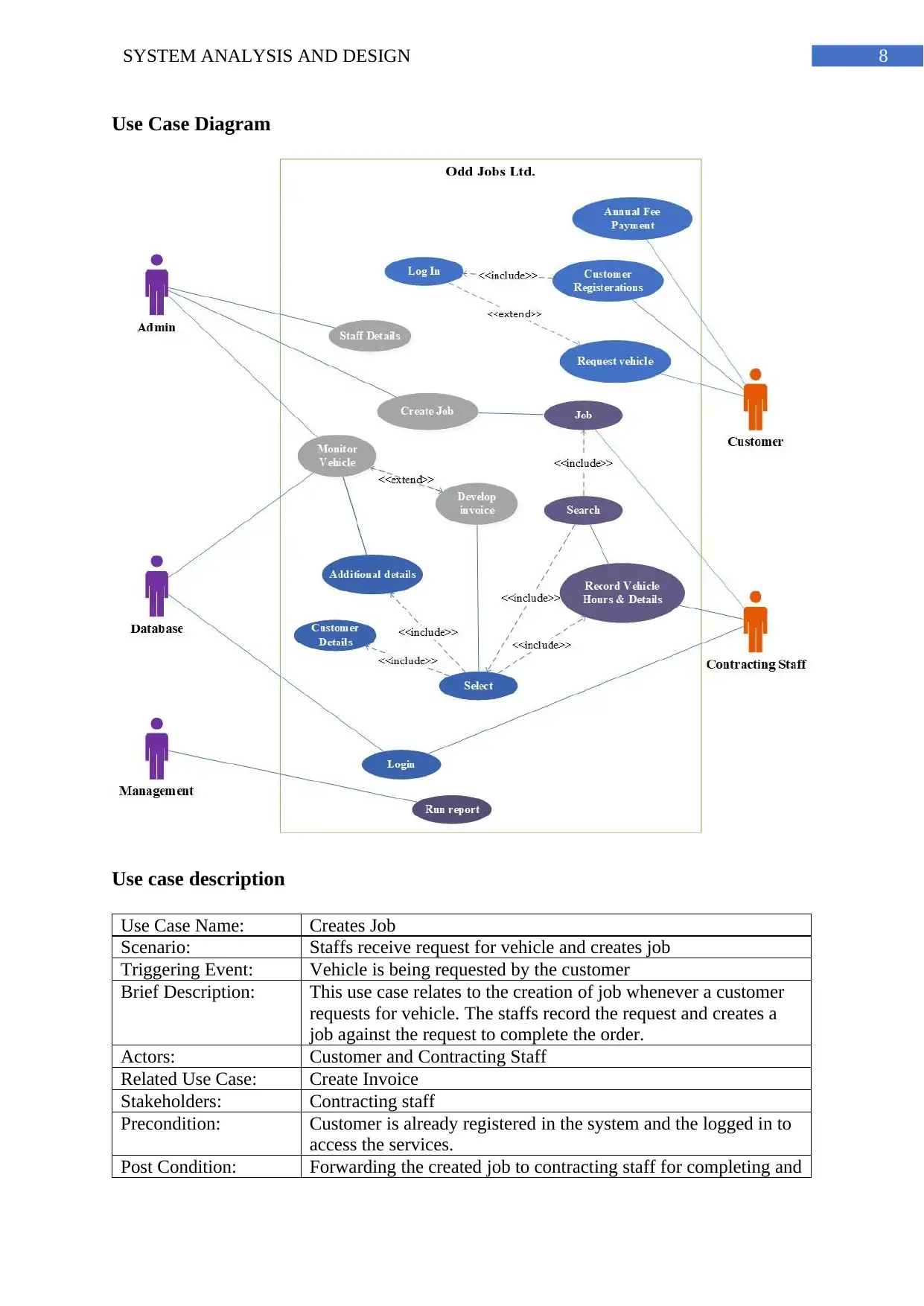
8SYSTEM ANALYSIS AND DESIGN
Use Case Diagram
Use case description
Use Case Name: Creates Job
Scenario: Staffs receive request for vehicle and creates job
Triggering Event: Vehicle is being requested by the customer
Brief Description: This use case relates to the creation of job whenever a customer
requests for vehicle. The staffs record the request and creates a
job against the request to complete the order.
Actors: Customer and Contracting Staff
Related Use Case: Create Invoice
Stakeholders: Contracting staff
Precondition: Customer is already registered in the system and the logged in to
access the services.
Post Condition: Forwarding the created job to contracting staff for completing and
Use Case Diagram
Use case description
Use Case Name: Creates Job
Scenario: Staffs receive request for vehicle and creates job
Triggering Event: Vehicle is being requested by the customer
Brief Description: This use case relates to the creation of job whenever a customer
requests for vehicle. The staffs record the request and creates a
job against the request to complete the order.
Actors: Customer and Contracting Staff
Related Use Case: Create Invoice
Stakeholders: Contracting staff
Precondition: Customer is already registered in the system and the logged in to
access the services.
Post Condition: Forwarding the created job to contracting staff for completing and
⊘ This is a preview!⊘
Do you want full access?
Subscribe today to unlock all pages.

Trusted by 1+ million students worldwide

9SYSTEM ANALYSIS AND DESIGN
it and recording the required details.
Flow of Activities: Actor Flow of Activities:
Customer registers and log in
to the system.
Customer requests for
vehicle.
Job is created by the
contracting staff against the
customer request.
Access the services through
registration and login.
Creation of Job.
Recording the job with customer
information.
Exception Conditions: Customer details has not been recorded by contracting staff for
the job
it and recording the required details.
Flow of Activities: Actor Flow of Activities:
Customer registers and log in
to the system.
Customer requests for
vehicle.
Job is created by the
contracting staff against the
customer request.
Access the services through
registration and login.
Creation of Job.
Recording the job with customer
information.
Exception Conditions: Customer details has not been recorded by contracting staff for
the job
Paraphrase This Document
Need a fresh take? Get an instant paraphrase of this document with our AI Paraphraser
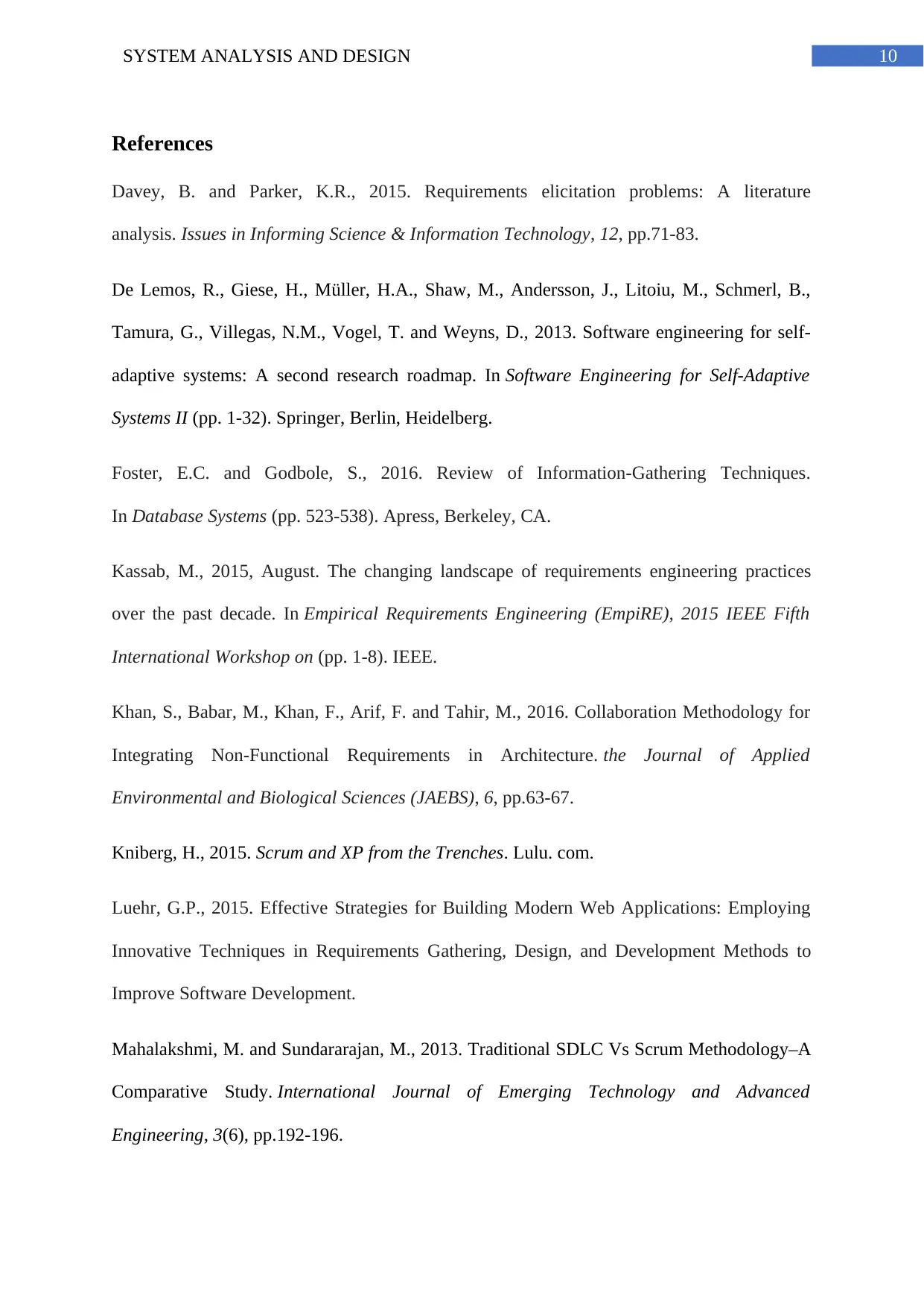
10SYSTEM ANALYSIS AND DESIGN
References
Davey, B. and Parker, K.R., 2015. Requirements elicitation problems: A literature
analysis. Issues in Informing Science & Information Technology, 12, pp.71-83.
De Lemos, R., Giese, H., Müller, H.A., Shaw, M., Andersson, J., Litoiu, M., Schmerl, B.,
Tamura, G., Villegas, N.M., Vogel, T. and Weyns, D., 2013. Software engineering for self-
adaptive systems: A second research roadmap. In Software Engineering for Self-Adaptive
Systems II (pp. 1-32). Springer, Berlin, Heidelberg.
Foster, E.C. and Godbole, S., 2016. Review of Information-Gathering Techniques.
In Database Systems (pp. 523-538). Apress, Berkeley, CA.
Kassab, M., 2015, August. The changing landscape of requirements engineering practices
over the past decade. In Empirical Requirements Engineering (EmpiRE), 2015 IEEE Fifth
International Workshop on (pp. 1-8). IEEE.
Khan, S., Babar, M., Khan, F., Arif, F. and Tahir, M., 2016. Collaboration Methodology for
Integrating Non-Functional Requirements in Architecture. the Journal of Applied
Environmental and Biological Sciences (JAEBS), 6, pp.63-67.
Kniberg, H., 2015. Scrum and XP from the Trenches. Lulu. com.
Luehr, G.P., 2015. Effective Strategies for Building Modern Web Applications: Employing
Innovative Techniques in Requirements Gathering, Design, and Development Methods to
Improve Software Development.
Mahalakshmi, M. and Sundararajan, M., 2013. Traditional SDLC Vs Scrum Methodology–A
Comparative Study. International Journal of Emerging Technology and Advanced
Engineering, 3(6), pp.192-196.
References
Davey, B. and Parker, K.R., 2015. Requirements elicitation problems: A literature
analysis. Issues in Informing Science & Information Technology, 12, pp.71-83.
De Lemos, R., Giese, H., Müller, H.A., Shaw, M., Andersson, J., Litoiu, M., Schmerl, B.,
Tamura, G., Villegas, N.M., Vogel, T. and Weyns, D., 2013. Software engineering for self-
adaptive systems: A second research roadmap. In Software Engineering for Self-Adaptive
Systems II (pp. 1-32). Springer, Berlin, Heidelberg.
Foster, E.C. and Godbole, S., 2016. Review of Information-Gathering Techniques.
In Database Systems (pp. 523-538). Apress, Berkeley, CA.
Kassab, M., 2015, August. The changing landscape of requirements engineering practices
over the past decade. In Empirical Requirements Engineering (EmpiRE), 2015 IEEE Fifth
International Workshop on (pp. 1-8). IEEE.
Khan, S., Babar, M., Khan, F., Arif, F. and Tahir, M., 2016. Collaboration Methodology for
Integrating Non-Functional Requirements in Architecture. the Journal of Applied
Environmental and Biological Sciences (JAEBS), 6, pp.63-67.
Kniberg, H., 2015. Scrum and XP from the Trenches. Lulu. com.
Luehr, G.P., 2015. Effective Strategies for Building Modern Web Applications: Employing
Innovative Techniques in Requirements Gathering, Design, and Development Methods to
Improve Software Development.
Mahalakshmi, M. and Sundararajan, M., 2013. Traditional SDLC Vs Scrum Methodology–A
Comparative Study. International Journal of Emerging Technology and Advanced
Engineering, 3(6), pp.192-196.
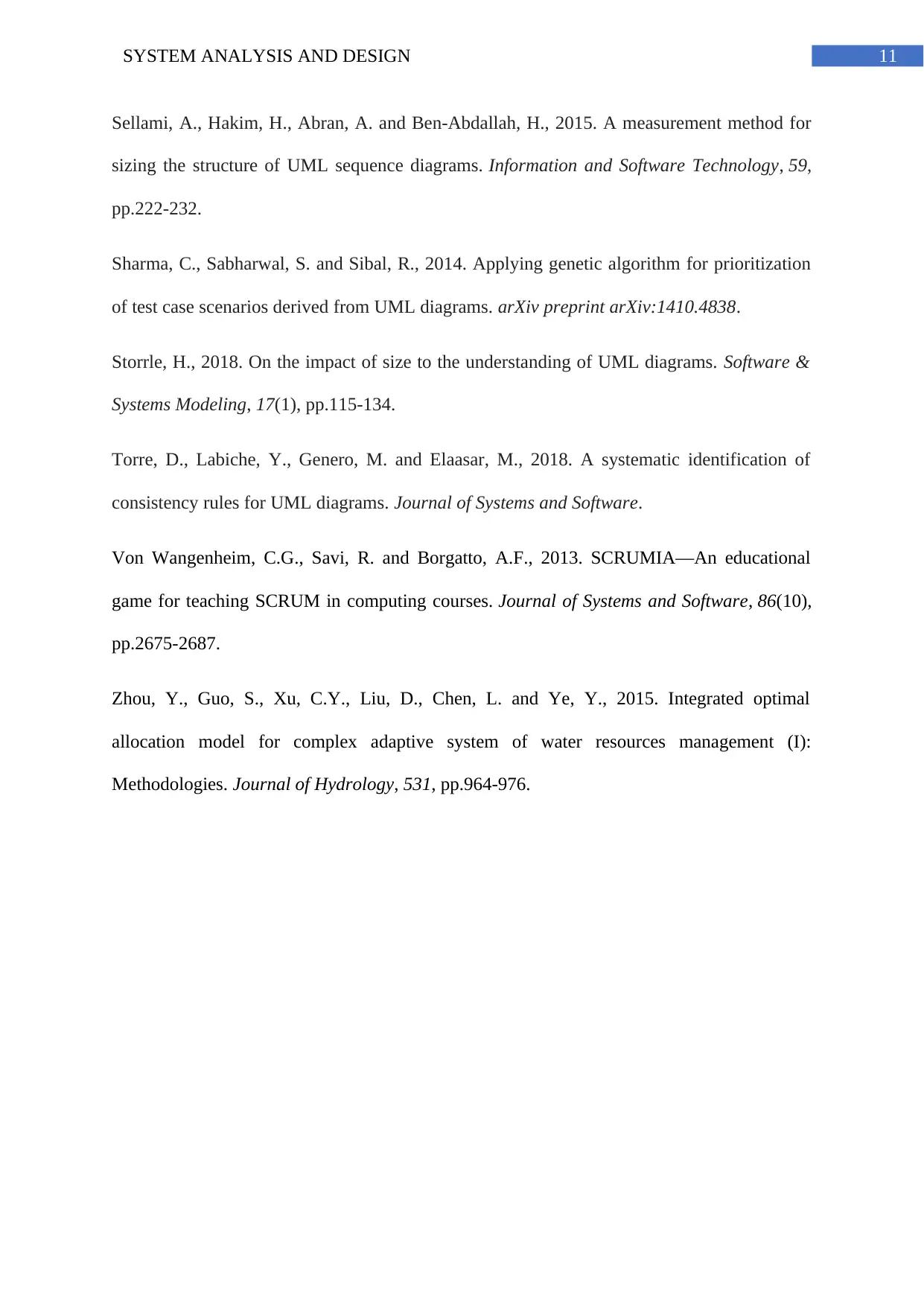
11SYSTEM ANALYSIS AND DESIGN
Sellami, A., Hakim, H., Abran, A. and Ben-Abdallah, H., 2015. A measurement method for
sizing the structure of UML sequence diagrams. Information and Software Technology, 59,
pp.222-232.
Sharma, C., Sabharwal, S. and Sibal, R., 2014. Applying genetic algorithm for prioritization
of test case scenarios derived from UML diagrams. arXiv preprint arXiv:1410.4838.
Storrle, H., 2018. On the impact of size to the understanding of UML diagrams. Software &
Systems Modeling, 17(1), pp.115-134.
Torre, D., Labiche, Y., Genero, M. and Elaasar, M., 2018. A systematic identification of
consistency rules for UML diagrams. Journal of Systems and Software.
Von Wangenheim, C.G., Savi, R. and Borgatto, A.F., 2013. SCRUMIA—An educational
game for teaching SCRUM in computing courses. Journal of Systems and Software, 86(10),
pp.2675-2687.
Zhou, Y., Guo, S., Xu, C.Y., Liu, D., Chen, L. and Ye, Y., 2015. Integrated optimal
allocation model for complex adaptive system of water resources management (I):
Methodologies. Journal of Hydrology, 531, pp.964-976.
Sellami, A., Hakim, H., Abran, A. and Ben-Abdallah, H., 2015. A measurement method for
sizing the structure of UML sequence diagrams. Information and Software Technology, 59,
pp.222-232.
Sharma, C., Sabharwal, S. and Sibal, R., 2014. Applying genetic algorithm for prioritization
of test case scenarios derived from UML diagrams. arXiv preprint arXiv:1410.4838.
Storrle, H., 2018. On the impact of size to the understanding of UML diagrams. Software &
Systems Modeling, 17(1), pp.115-134.
Torre, D., Labiche, Y., Genero, M. and Elaasar, M., 2018. A systematic identification of
consistency rules for UML diagrams. Journal of Systems and Software.
Von Wangenheim, C.G., Savi, R. and Borgatto, A.F., 2013. SCRUMIA—An educational
game for teaching SCRUM in computing courses. Journal of Systems and Software, 86(10),
pp.2675-2687.
Zhou, Y., Guo, S., Xu, C.Y., Liu, D., Chen, L. and Ye, Y., 2015. Integrated optimal
allocation model for complex adaptive system of water resources management (I):
Methodologies. Journal of Hydrology, 531, pp.964-976.
⊘ This is a preview!⊘
Do you want full access?
Subscribe today to unlock all pages.

Trusted by 1+ million students worldwide
1 out of 15
Related Documents
Your All-in-One AI-Powered Toolkit for Academic Success.
+13062052269
info@desklib.com
Available 24*7 on WhatsApp / Email
![[object Object]](/_next/static/media/star-bottom.7253800d.svg)
Unlock your academic potential
Copyright © 2020–2025 A2Z Services. All Rights Reserved. Developed and managed by ZUCOL.




